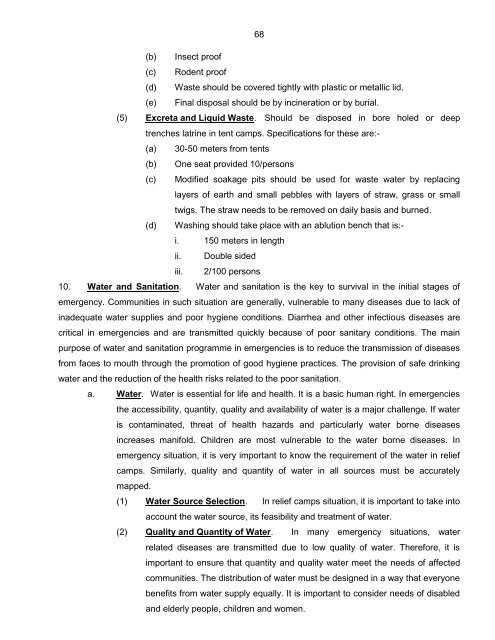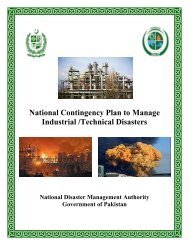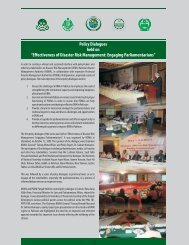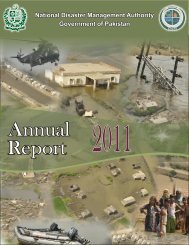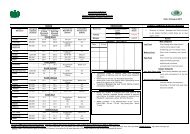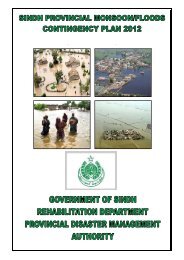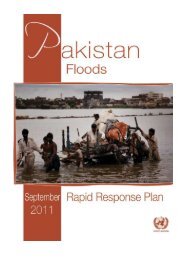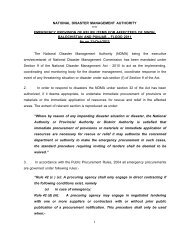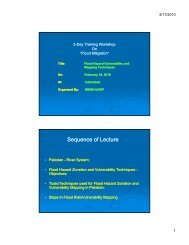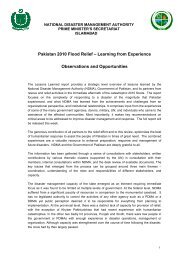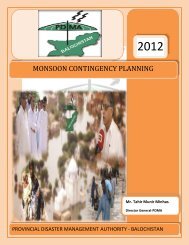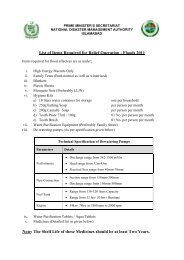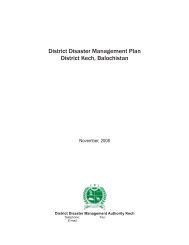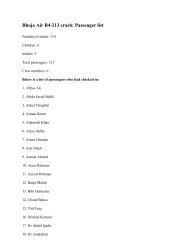National Disaster Response Plan (NDRP) March 2010 - NDMA
National Disaster Response Plan (NDRP) March 2010 - NDMA
National Disaster Response Plan (NDRP) March 2010 - NDMA
Create successful ePaper yourself
Turn your PDF publications into a flip-book with our unique Google optimized e-Paper software.
(b) Insect proof<br />
(c) Rodent proof<br />
68<br />
(d) Waste should be covered tightly with plastic or metallic lid.<br />
(e) Final disposal should be by incineration or by burial.<br />
(5) Excreta and Liquid Waste. Should be disposed in bore holed or deep<br />
trenches latrine in tent camps. Specifications for these are:-<br />
(a) 30-50 meters from tents<br />
(b) One seat provided 10/persons<br />
(c) Modified soakage pits should be used for waste water by replacing<br />
layers of earth and small pebbles with layers of straw, grass or small<br />
twigs. The straw needs to be removed on daily basis and burned.<br />
(d) Washing should take place with an ablution bench that is:-<br />
i. 150 meters in length<br />
ii. Double sided<br />
iii. 2/100 persons<br />
10. Water and Sanitation. Water and sanitation is the key to survival in the initial stages of<br />
emergency. Communities in such situation are generally, vulnerable to many diseases due to lack of<br />
inadequate water supplies and poor hygiene conditions. Diarrhea and other infectious diseases are<br />
critical in emergencies and are transmitted quickly because of poor sanitary conditions. The main<br />
purpose of water and sanitation programme in emergencies is to reduce the transmission of diseases<br />
from faces to mouth through the promotion of good hygiene practices. The provision of safe drinking<br />
water and the reduction of the health risks related to the poor sanitation.<br />
a. Water. Water is essential for life and health. It is a basic human right. In emergencies<br />
the accessibility, quantity, quality and availability of water is a major challenge. If water<br />
is contaminated, threat of health hazards and particularly water borne diseases<br />
increases manifold. Children are most vulnerable to the water borne diseases. In<br />
emergency situation, it is very important to know the requirement of the water in relief<br />
camps. Similarly, quality and quantity of water in all sources must be accurately<br />
mapped.<br />
(1) Water Source Selection. In relief camps situation, it is important to take into<br />
account the water source, its feasibility and treatment of water.<br />
(2) Quality and Quantity of Water. In many emergency situations, water<br />
related diseases are transmitted due to low quality of water. Therefore, it is<br />
important to ensure that quantity and quality water meet the needs of affected<br />
communities. The distribution of water must be designed in a way that everyone<br />
benefits from water supply equally. It is important to consider needs of disabled<br />
and elderly people, children and women.


